英国伦敦牛津街OXford street
世界十大最有魅力城市商业步行街

世界十大最有魅力城市商业步行街世界十大最有魅力城市商业步行街提要:第一名:美国纽约第五大道FIFTHAVENUE关键词:时尚大气地理位置:美国纽约曼哈顿历史:1907年成立了第五大街协会。
地产所有者,经济承租人,和零售商在一年间大约集资世界十大最有魅力城市商业步行街商业步行街是城市形象的代表,是城市的名片。
理念设计是商业步行街策划的灵魂,步行街策划要考虑步行街的商圈特征、消费习惯、区域历史文化、建筑与商业文化。
理念的设计要在商业街历史基础上创新,兼顾历史特点,更重要的是有利于未来发展。
透过国外优秀商业街的成熟模式,我们可以看到国内商业街如北京王府井,上海新天地等不管是在建筑的保留与结合,还是商业运作,都存在较大的差距。
第一名:美国纽约第五大道FIFTHAVENUE关键词:时尚大气地理位置:美国纽约曼哈顿历史:1907年成立了第五大街协会。
地产所有者,经济承租人,和零售商在一年间大约集资了180万来提供商业区需要和政府服务的空项。
协会雇佣了相当于城市警力5倍的社区安全员来保障治安。
衍生:是以第五大道对纽约经济的贡献来做到这一点的。
举一个去年的例子来说,仅零售商的私人投资就高于500万美元。
这些投资造就了成千上万份工作的诞生,同时,私人和公司的收入也为政府创造了高额的税收。
另外,雇工又把资金返还于临近商业部门,从而帮助了当地经济的繁荣发展。
商业:第61街附近的PIERRE酒店,第59街上的PLAZA酒店都位于中央公园周边。
面向南方,有TIFFANy,GUccI这样的名店。
这些经典名店之间还有PULITZER喷泉,RockEFELLER 中心和圣PATRck′S大教堂。
第二名:法国巴黎香榭丽舍大街cHAmPS-ELySEES关键词:文化情调金碧辉煌地理位置:香谢丽舍大街将巴黎分为南北两半,它西接凯旋门,东连协和广场,全长1880米。
概况:香榭丽舍大街是巴黎之魂,大街的东半部分是700米长的林荫大道,是闹市中不可多得的一块清幽之处。
伦敦关于零售消费业相关的景点
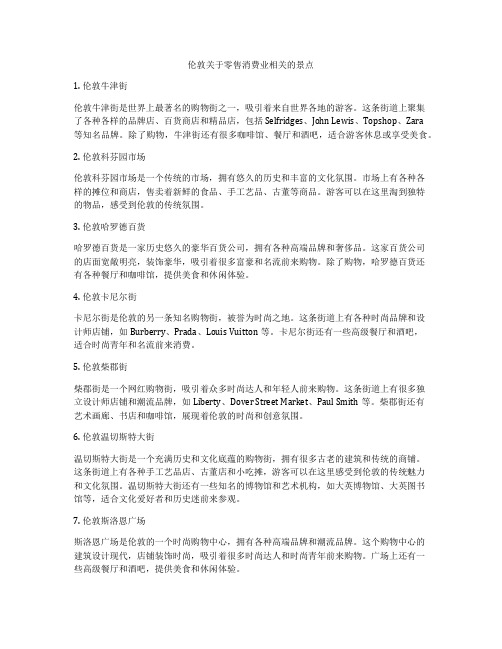
伦敦关于零售消费业相关的景点1. 伦敦牛津街伦敦牛津街是世界上最著名的购物街之一,吸引着来自世界各地的游客。
这条街道上聚集了各种各样的品牌店、百货商店和精品店,包括Selfridges、John Lewis、Topshop、Zara等知名品牌。
除了购物,牛津街还有很多咖啡馆、餐厅和酒吧,适合游客休息或享受美食。
2. 伦敦科芬园市场伦敦科芬园市场是一个传统的市场,拥有悠久的历史和丰富的文化氛围。
市场上有各种各样的摊位和商店,售卖着新鲜的食品、手工艺品、古董等商品。
游客可以在这里淘到独特的物品,感受到伦敦的传统氛围。
3. 伦敦哈罗德百货哈罗德百货是一家历史悠久的豪华百货公司,拥有各种高端品牌和奢侈品。
这家百货公司的店面宽敞明亮,装饰豪华,吸引着很多富豪和名流前来购物。
除了购物,哈罗德百货还有各种餐厅和咖啡馆,提供美食和休闲体验。
4. 伦敦卡尼尔街卡尼尔街是伦敦的另一条知名购物街,被誉为时尚之地。
这条街道上有各种时尚品牌和设计师店铺,如Burberry、Prada、Louis Vuitton等。
卡尼尔街还有一些高级餐厅和酒吧,适合时尚青年和名流前来消费。
5. 伦敦柴郡街柴郡街是一个网红购物街,吸引着众多时尚达人和年轻人前来购物。
这条街道上有很多独立设计师店铺和潮流品牌,如Liberty、Dover Street Market、Paul Smith等。
柴郡街还有艺术画廊、书店和咖啡馆,展现着伦敦的时尚和创意氛围。
6. 伦敦温切斯特大街温切斯特大街是一个充满历史和文化底蕴的购物街,拥有很多古老的建筑和传统的商铺。
这条街道上有各种手工艺品店、古董店和小吃摊,游客可以在这里感受到伦敦的传统魅力和文化氛围。
温切斯特大街还有一些知名的博物馆和艺术机构,如大英博物馆、大英图书馆等,适合文化爱好者和历史迷前来参观。
7. 伦敦斯洛恩广场斯洛恩广场是伦敦的一个时尚购物中心,拥有各种高端品牌和潮流品牌。
这个购物中心的建筑设计现代,店铺装饰时尚,吸引着很多时尚达人和时尚青年前来购物。
伦敦牛津街的地理位置
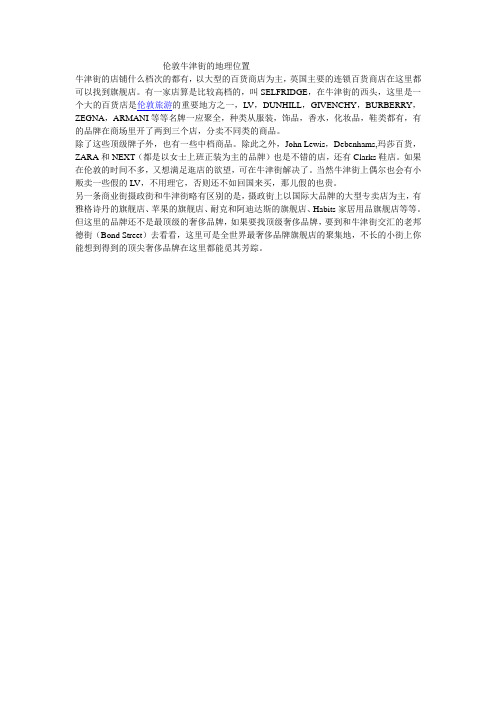
伦敦牛津街的地理位置
牛津街的店铺什么档次的都有,以大型的百货商店为主,英国主要的连锁百货商店在这里都可以找到旗舰店。
有一家店算是比较高档的,叫SELFRIDGE,在牛津街的西头,这里是一个大的百货店是伦敦旅游的重要地方之一,LV,DUNHILL,GIVENCHY,BURBERRY,ZEGNA,ARMANI等等名牌一应聚全,种类从服装,饰品,香水,化妆品,鞋类都有,有的品牌在商场里开了两到三个店,分卖不同类的商品。
除了这些顶级牌子外,也有一些中档商品。
除此之外,John Lewis,Debenhams,玛莎百货,ZARA和NEXT(都是以女士上班正装为主的品牌)也是不错的店,还有Clarks鞋店。
如果在伦敦的时间不多,又想满足逛店的欲望,可在牛津街解决了。
当然牛津街上偶尔也会有小贩卖一些假的LV,不用理它,否则还不如回国来买,那儿假的也贵。
另一条商业街摄政街和牛津街略有区别的是,摄政街上以国际大品牌的大型专卖店为主,有雅格诗丹的旗舰店、苹果的旗舰店、耐克和阿迪达斯的旗舰店、Habits家居用品旗舰店等等。
但这里的品牌还不是最顶级的奢侈品牌,如果要找顶级奢侈品牌,要到和牛津街交汇的老邦德街(Bond Street)去看看,这里可是全世界最奢侈品牌旗舰店的聚集地,不长的小街上你能想到得到的顶尖奢侈品牌在这里都能觅其芳踪。
英国三条著名购物大街详解
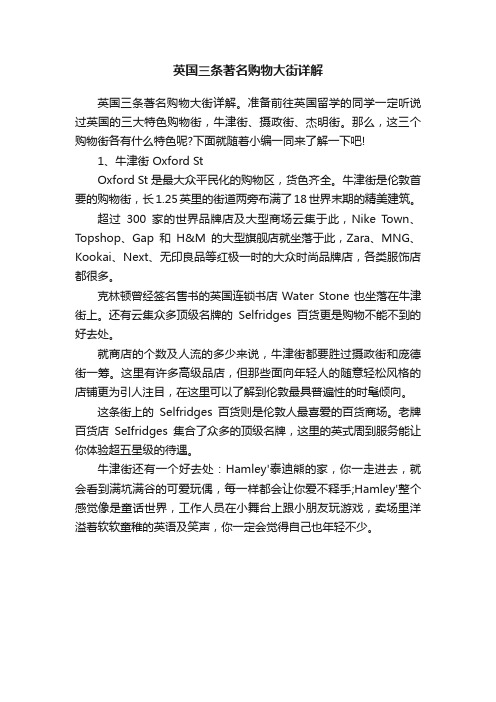
英国三条著名购物大街详解
英国三条著名购物大街详解。
准备前往英国留学的同学一定听说过英国的三大特色购物街,牛津街、摄政街、杰明街。
那么,这三个购物街各有什么特色呢?下面就随着小编一同来了解一下吧!
1、牛津街 Oxford St
Oxford St 是最大众平民化的购物区,货色齐全。
牛津街是伦敦首要的购物街,长1.25英里的街道两旁布满了18世界末期的精美建筑。
超过300家的世界品牌店及大型商场云集于此,Nike Town、Topshop、Gap和H&M的大型旗舰店就坐落于此,Zara、MNG、Kookai、Next、无印良品等红极一时的大众时尚品牌店,各类服饰店都很多。
克林顿曾经签名售书的英国连锁书店Water Stone也坐落在牛津街上。
还有云集众多顶级名牌的Selfridges百货更是购物不能不到的好去处。
就商店的个数及人流的多少来说,牛津街都要胜过摄政街和庞德街一筹。
这里有许多高级品店,但那些面向年轻人的随意轻松风格的店铺更为引人注目,在这里可以了解到伦敦最具普遍性的时髦倾向。
这条街上的Selfridges百货则是伦敦人最喜爱的百货商场。
老牌百货店SeIfridges集合了众多的顶级名牌,这里的英式周到服务能让你体验超五星级的待遇。
牛津街还有一个好去处:Hamley'泰迪熊的家,你一走进去,就会看到满坑满谷的可爱玩偶,每一样都会让你爱不释手;Hamley'整个感觉像是童话世界,工作人员在小舞台上跟小朋友玩游戏,卖场里洋溢着软软童稚的英语及笑声,你一定会觉得自己也年轻不少。
牛津街主题活动方案策划

一、活动背景牛津街,作为英国伦敦最繁华的商业街之一,历史悠久,文化底蕴深厚。
为了进一步提升牛津街的知名度,丰富市民文化生活,打造特色旅游目的地,我们特此策划一场以“探寻历史足迹,感受时尚魅力”为主题的活动。
本次活动旨在通过丰富多彩的文化、娱乐、商业活动,吸引游客和市民参与,提升牛津街的活力与魅力。
二、活动主题“探寻历史足迹,感受时尚魅力”三、活动目标1. 提升牛津街的知名度和美誉度;2. 吸引游客和市民参与,促进消费;3. 传承和弘扬英国历史文化;4. 打造特色旅游目的地,推动旅游业发展。
四、活动时间2023年5月1日至5月7日五、活动地点牛津街及周边区域六、活动内容1. 开幕式时间:2023年5月1日上午10:00地点:牛津街中央广场内容:- 领导致辞;- 传统文艺表演;- 活动启动仪式;- 首批游客免费体验活动。
2. 历史文化展览时间:2023年5月1日至5月7日地点:牛津街购物中心、博物馆、画廊等内容:- 英国历史文化展览;- 传统手工艺品展示;- 英伦风情摄影展;- 文化讲座和研讨会。
3. 时尚秀时间:2023年5月2日、5月5日地点:牛津街购物中心内容:- 国际知名设计师时装秀;- 伦敦街头时尚文化展示;- 时尚配饰和化妆品品牌体验;- 时尚摄影大赛。
4. 美食节时间:2023年5月3日至5月5日地点:牛津街周边餐饮区域内容:- 英国传统美食展示;- 各国美食摊位;- 美食烹饪表演;- 美食评比活动。
5. 夜市狂欢时间:2023年5月6日、5月7日地点:牛津街内容:- 夜市摊位;- 音乐、舞蹈表演;- 特色游戏和互动环节;- 灯光秀和烟花表演。
6. 亲子活动时间:2023年5月4日地点:牛津街购物中心内容:- 亲子手工制作;- 童话故事表演;- 亲子互动游戏;- 童趣摄影大赛。
7. 慈善公益活动时间:2023年5月7日地点:牛津街购物中心内容:- 慈善义卖;- 爱心捐赠;- 公益讲座;- 环保宣传。
英国有哪些购物的地方
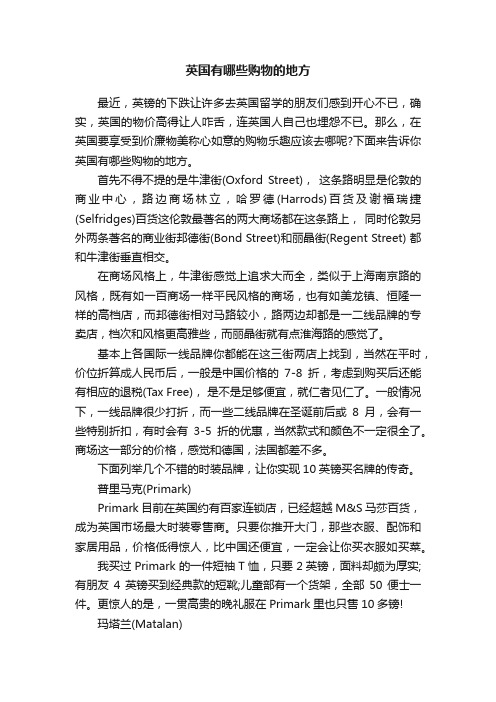
英国有哪些购物的地方最近,英镑的下跌让许多去英国留学的朋友们感到开心不已,确实,英国的物价高得让人咋舌,连英国人自己也埋怨不已。
那么,在英国要享受到价廉物美称心如意的购物乐趣应该去哪呢?下面来告诉你英国有哪些购物的地方。
首先不得不提的是牛津街(Oxford Street),这条路明显是伦敦的商业中心,路边商场林立,哈罗德(Harrods)百货及谢福瑞捷(Selfridges)百货这伦敦最著名的两大商场都在这条路上,同时伦敦另外两条著名的商业街邦德街(Bond Street)和丽晶街(Regent Street) 都和牛津街垂直相交。
在商场风格上,牛津街感觉上追求大而全,类似于上海南京路的风格,既有如一百商场一样平民风格的商场,也有如美龙镇、恒隆一样的高档店,而邦德街相对马路较小,路两边却都是一二线品牌的专卖店,档次和风格更高雅些,而丽晶街就有点淮海路的感觉了。
基本上各国际一线品牌你都能在这三街两店上找到,当然在平时,价位折算成人民币后,一般是中国价格的7-8折,考虑到购买后还能有相应的退税(Tax Free),是不是足够便宜,就仁者见仁了。
一般情况下,一线品牌很少打折,而一些二线品牌在圣诞前后或8月,会有一些特别折扣,有时会有3-5折的优惠,当然款式和颜色不一定很全了。
商场这一部分的价格,感觉和德国,法国都差不多。
下面列举几个不错的时装品牌,让你实现10英镑买名牌的传奇。
普里马克(Primark)Primark目前在英国约有百家连锁店,已经超越M&S马莎百货,成为英国市场最大时装零售商。
只要你推开大门,那些衣服、配饰和家居用品,价格低得惊人,比中国还便宜,一定会让你买衣服如买菜。
我买过Primark的一件短袖T恤,只要2英镑,面料却颇为厚实;有朋友4英镑买到经典款的短靴;儿童部有一个货架,全部50便士一件。
更惊人的是,一贯高贵的晚礼服在Primark里也只售10多镑!玛塔兰(Matalan)Matalan以难以置信的超低价格出售当季所有的最新时装,包括顶级设计师的作品,以及各种家居用品,所谓的高贵不贵。
英国留学 英国有哪些著名的购物场所
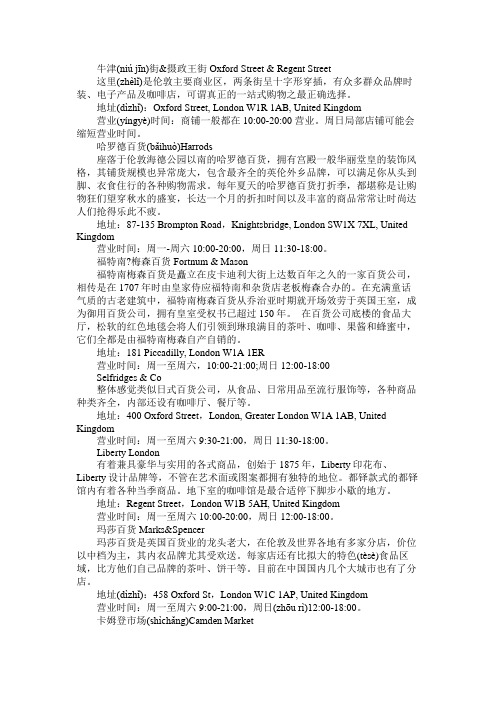
牛津(niú jīn)街&摄政王街Oxford Street & Regent Street这里(zhèlǐ)是伦敦主要商业区,两条街呈十字形穿插,有众多群众品牌时装、电子产品及咖啡店,可谓真正的一站式购物之最正确选择。
地址(dìzhǐ):Oxford Street, London W1R 1AB, United Kingdom营业(yíngyè)时间:商铺一般都在10:00-20:00 营业。
周日局部店铺可能会缩短营业时间。
哈罗德百货(bǎihuò)Harrods座落于伦敦海德公园以南的哈罗德百货,拥有宫殿一般华丽堂皇的装饰风格,其铺货规模也异常庞大,包含最齐全的英伦外乡品牌,可以满足你从头到脚、衣食住行的各种购物需求。
每年夏天的哈罗德百货打折季,都堪称是让购物狂们望穿秋水的盛宴,长达一个月的折扣时间以及丰富的商品常常让时尚达人们抢得乐此不疲。
地址:87-135 Brompton Road,Knightsbridge, London SW1X 7XL, United Kingdom营业时间:周一-周六 10:00-20:00,周日11:30-18:00。
福特南?梅森百货Fortnum & Mason福特南梅森百货是矗立在皮卡迪利大街上达数百年之久的一家百货公司,相传是在1707年时由皇家侍应福特南和杂货店老板梅森合办的。
在充满童话气质的古老建筑中,福特南梅森百货从乔治亚时期就开场效劳于英国王室,成为御用百货公司,拥有皇室受权书已超过150年。
在百货公司底楼的食品大厅,松软的红色地毯会将人们引领到琳琅满目的茶叶、咖啡、果酱和蜂蜜中,它们全都是由福特南梅森自产自销的。
地址:181 Piccadilly, London W1A 1ER营业时间:周一至周六,10:00-21:00;周日12:00-18:00Selfridges & Co整体感觉类似日式百货公司,从食品、日常用品至流行服饰等,各种商品种类齐全,内部还设有咖啡厅、餐厅等。
世界著名商业街TOP20

Orchard Street
28
新加坡 乌节路
乌节路位于新加坡的中心位置,范围 从唐林路一直延伸到Bras Basah路,是 一条全长约为2.2公里的单行道,特色购 物中心林立于道路两侧,各大购物中心外 的主要通道则布满了这个花园城市无处不 在的鲜花和绿叶。
每一个标志性的购物中心都是购物者 的天堂,提供了拥有自己特色的零售,餐 饮和娱乐服务。这个购物带由近800,000 平方米的商场、餐厅组成。从世界名品定 制到快速时尚,从高档餐厅到美食广场能 满足不同消费层次的要求。
在这条日客流量达50万人的地下网络中,包含 了60个住宅和商业综合楼,建筑面积达360万平方 米,占去了蒙特利尔市整个商务中心区80%的办公 面积和35%的商业面积。
Montreal Underground City
26
新加坡 乌节路
Orchard Street
27
新加坡 乌节路
18世纪中40年代,乌节路一带还是 一片豆蔻和胡椒园。1900后一场瘟疫将 园内一切尽数摧毁,接下来又是水灾, 直到1965年莱佛士水道加宽加深后才获 改善。1970年后,摩登现代、光鲜亮丽 的商业中心如雨后春笋般兴起,乌节路 变成举世赞誉的名店街。
Carinthia Street
17
奥地利维也纳 克恩顿大街
在大街的入口处坐落着世界最著 名的歌剧院--维也纳国家歌剧院。在“金 色的U字”的中央地带则坐落维也纳最 大、最重要的主教教堂——史蒂芬教 堂。
当我们闲逛到这个步行区的终点 时,等待我们的是米夏埃尔广场和米 夏埃尔门。从米夏埃尔门可以通向维 也纳胡浮堡皇宫--以前的国王和现在的 联邦总统都可以在里面行使权力。
著名诗人普希金从1830年起居住 在这条大街上,普希金故居就坐落在 阿尔巴特街53号。阿尔巴特街曾是艺 人和画家荟萃的天堂,保存有许多古 色古香的建筑。
英国伦敦旅游攻略
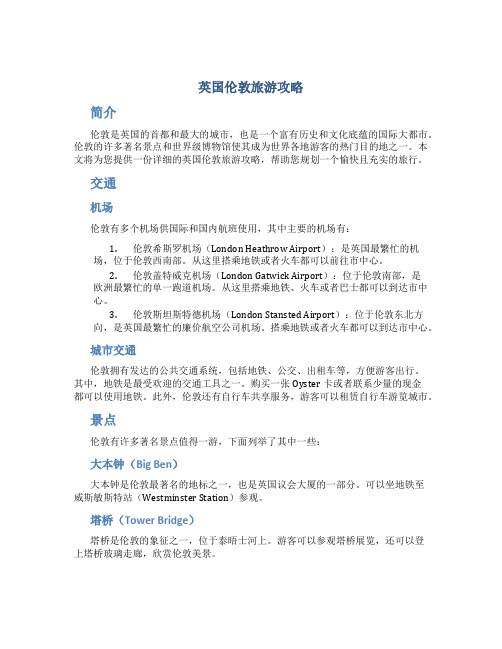
英国伦敦旅游攻略简介伦敦是英国的首都和最大的城市,也是一个富有历史和文化底蕴的国际大都市。
伦敦的许多著名景点和世界级博物馆使其成为世界各地游客的热门目的地之一。
本文将为您提供一份详细的英国伦敦旅游攻略,帮助您规划一个愉快且充实的旅行。
交通机场伦敦有多个机场供国际和国内航班使用,其中主要的机场有:1.伦敦希斯罗机场(London Heathrow Airport):是英国最繁忙的机场,位于伦敦西南部。
从这里搭乘地铁或者火车都可以前往市中心。
2.伦敦盖特威克机场(London Gatwick Airport):位于伦敦南部,是欧洲最繁忙的单一跑道机场。
从这里搭乘地铁、火车或者巴士都可以到达市中心。
3.伦敦斯坦斯特德机场(London Stansted Airport):位于伦敦东北方向,是英国最繁忙的廉价航空公司机场。
搭乘地铁或者火车都可以到达市中心。
城市交通伦敦拥有发达的公共交通系统,包括地铁、公交、出租车等,方便游客出行。
其中,地铁是最受欢迎的交通工具之一。
购买一张Oyster卡或者联系少量的现金都可以使用地铁。
此外,伦敦还有自行车共享服务,游客可以租赁自行车游览城市。
景点伦敦有许多著名景点值得一游,下面列举了其中一些:大本钟(Big Ben)大本钟是伦敦最著名的地标之一,也是英国议会大厦的一部分。
可以坐地铁至威斯敏斯特站(Westminster Station)参观。
塔桥(Tower Bridge)塔桥是伦敦的象征之一,位于泰晤士河上。
游客可以参观塔桥展览,还可以登上塔桥玻璃走廊,欣赏伦敦美景。
大英博物馆(British Museum)大英博物馆是世界上最重要的博物馆之一,展示了全球文明的珍贵文物。
参观博物馆是免费的,值得花上几个小时深入探索。
白金汉宫(Buckingham Palace)白金汉宫是英国女王的正式居所,也是每日更换卫兵的地方。
参观者可以参观宫殿的一部分,还可以观看卫兵换岗仪式。
oxford翻译
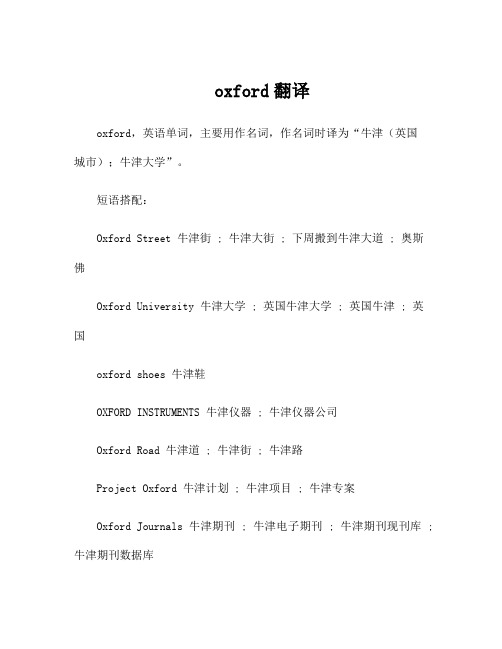
oxford翻译oxford,英语单词,主要用作名词,作名词时译为“牛津(英国城市);牛津大学”。
短语搭配:Oxford Street 牛津街 ; 牛津大街 ; 下周搬到牛津大道 ; 奥斯佛Oxford University 牛津大学 ; 英国牛津大学 ; 英国牛津 ; 英国oxford shoes 牛津鞋OXFORD INSTRUMENTS 牛津仪器 ; 牛津仪器公司Oxford Road 牛津道 ; 牛津街 ; 牛津路Project Oxford 牛津计划 ; 牛津项目 ; 牛津专案Oxford Journals 牛津期刊 ; 牛津电子期刊 ; 牛津期刊现刊库 ; 牛津期刊数据库oxford blue 牛津蓝 ; 牛津大学代表队的深蓝色服装 ; 紫蓝色Oxford Castle 牛津城堡例句:1、As a place to live, Oxford takes some beating.就居住环境而论,牛津市是个难得的好地方。
2、He was educated at his local comprehensive school and then at Oxford.他先在地方综合学校然后在牛津大学接受教育。
3、Oxford has a lot to offer visitors in the way of entertainment.牛津能向来访者提供很多娱乐活动。
4、Botley is well serviced by a regular bus route into Oxford.从博特利到牛津有一路公共汽车,按时发车,十分便利。
5、I met the young Bill Clinton at Oxford.比尔∙克林顿年轻的时候,我在牛津见过他。
Oxford Street 牛津街
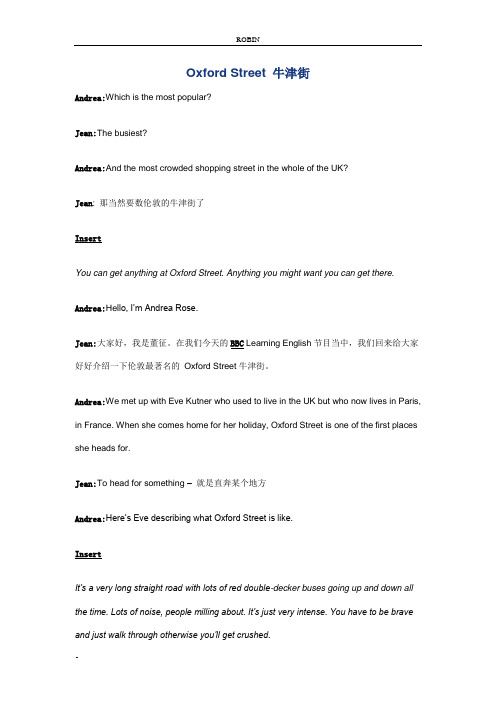
Oxford Street 牛津街Andrea:Which is the most popular?Jean:The busiest?Andrea:And the most crowded shopping street in the whole of the UK?Jean: 那当然要数伦敦的牛津街了InsertYou can get anything at Oxford Street. Anything you might want you can get there. Andrea:He llo, I’m Andrea Rose.Jean:大家好,我是董征。
在我们今天的BBC Learning English节目当中,我们回来给大家好好介绍一下伦敦最著名的Oxford Street牛津街。
Andrea:We met up with Eve Kutner who used to live in the UK but who now lives in Paris, in France. When she comes home for her holiday, Oxford Street is one of the first places she heads for.Jean:To head for something –就是直奔某个地方Andrea:Here’s Eve describing what Oxford Street is like.InsertIt’s a very long straight road with lots of red double-decker buses going up and down all the time. Lots of noise, people milling about. It’s just very intense. You have to be brave and just walk through otherwise you’ll get crushed.Jean:Eve她说这条Oxford Street是一条又长又直的街道。
英国伦敦牛津街OXford street

英国伦敦牛津街OXford street牛津街是英国首要的购物街,每年吸引了来自全球的3千万游客到此观光购物。
它是伦敦西区购物的中心,是英国最繁忙的街道。
众多的购物者都被这条长1.25英里的街道上云集的超过300家的世界大型商场所吸引。
牛津街享有遍及全球的声誉,它不仅吸引了英国其它地方的游客,也吸引了大量的海外游客。
据估计,每年有9百万外国游客来这里参观购物,他们在这里的消费占牛津街全部收入的20%。
如同零售一样,这条街也是千万人的工作场所。
在圣诞节的高峰时期,这里有大约6万人。
牛津街还为伦敦的中心提供了一条重要的交通干线,每小时有50辆公共汽车运行,4个地铁站与5条线路相连,从而确保了公共运输网的核心地理位置。
历史从罗马时代直到17世纪,牛津街主要室作为从伦敦西城之外到牛津地区的线路而存在的。
那时最东部地区已经在南边有所发展,但是北边还没有什么重大发展。
18世纪末期,主要的有大片建筑物的土地的兴建,即南部高斯弯那Grosvenor,北部波特曼Portman和波特兰Portland (今日的霍华德沃顿Howard de Walden) 的兴建使得牛津街很大程度上成为现在的样子。
一流的购物中心在20世纪开始起步,同时也伴随着一些正在向主要商店发展的小店铺的开业,像1865年首次开业的赛尔夫瑞至(Selfridges),它比较大的一部分在1929年才面向公众。
现在的情形2001年1月对牛津街零售商进行的调查表明,对于2/3的受调查人来说,买卖金额普遍有所升高,且预期在今后12个月里还会升高。
然而55%的人们坚持认为牛津街的综合贸易额受到了蓝水(Blue Water)——一家最近在伦敦东边城外建造的购物中心——的不利影响。
这也是为什么有越来越多的声音呼吁牛津街在环境上更进一步优化治理的原因之一。
以前的改进牛津街,牛津广场西部的改进是在1992年2月到1995年11月期间实行的。
方案是通过资金计划,根据商业贡献制订的。
欣赏伦敦十大最时尚的潮流地标
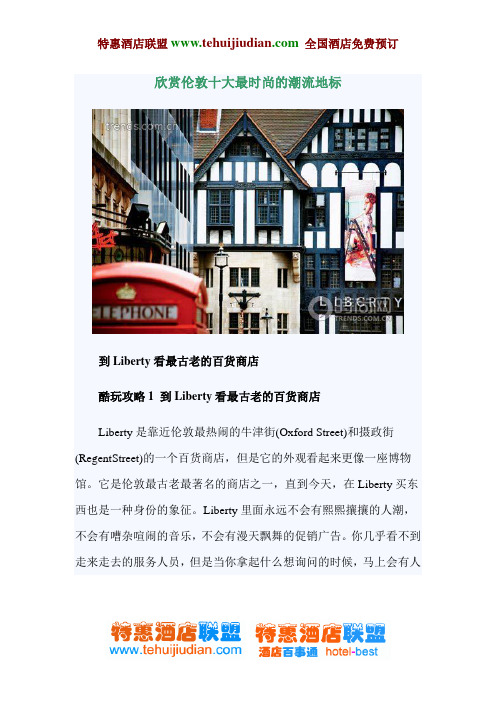
欣赏伦敦十大最时尚的潮流地标到Liberty看最古老的百货商店酷玩攻略1 到Liberty看最古老的百货商店Liberty是靠近伦敦最热闹的牛津街(Oxford Street)和摄政街(RegentStreet)的一个百货商店,但是它的外观看起来更像一座博物馆。
它是伦敦最古老最著名的商店之一,直到今天,在Liberty买东西也是一种身份的象征。
Liberty里面永远不会有熙熙攘攘的人潮,不会有嘈杂喧闹的音乐,不会有漫天飘舞的促销广告。
你几乎看不到走来走去的服务人员,但是当你拿起什么想询问的时候,马上会有人神奇地出现在你面前。
就算什么都不买也要进去感受一把,绝对的英国范儿购物体验!在西区看一场经典音乐剧酷玩攻略2 在西区看一场经典音乐剧在伦敦如果不去西区(West End)听歌剧,就跟到了纽约不去百老汇一样可惜。
事实上,历史上第一部音乐剧——约翰·凯的《乞丐的歌剧》正是1728年于伦敦首演。
在伦敦西区剧院里上演的音乐剧制作非常精良,演员功力、剧情节奏、舞台效果代表世界最高水平。
坐在具有百年历史的古老剧院里,欣赏正宗伦敦音唱腔的歌剧,身边坐着衣着讲究的绅士、淑女,你觉得自己都穿越成戏中人了。
推荐剧目:《悲惨世界》、《歌剧魅影》、《猫》、《妈妈咪呀》。
票价:从12-50英镑不等(高价位票提前购买折扣很大,性价比极高),可以通过网站也可以在伦敦的很多Box Office提前购买。
来一顿时尚不贵的英式下午茶酷玩攻略3 来一顿时尚不贵的英式下午茶在英国喝下午茶,就跟咱们广东人吃早茶一样,是一种放松的社交方式。
不一定非要在高级餐厅或者高级酒店,伦敦遍布很多平民化的下午茶室。
比如位于Piccadilly大街的Fortnumand Masons,这是一家以卖茶叶起家有300多年历史的精品百货店,位于二层的茶室门口永远大排长龙。
价格合理且分量很足,纯银的茶壶非常有手感。
只是英国的甜品着实比较甜腻,以咱们的中式胃,还是浅尝辄止吧。
血拼必备!2016英国伦敦购物攻略之服饰篇

血拼必备!2016英国伦敦购物攻略之服饰篇市中心购物区伦敦有许多不同的购物地点,散布在伦敦各区,其中商品最多,种类最齐全的就是Oxford Street和Regent Street。
Oxford Street和Regent Street是伦敦首屈一指的购物街,每年圣诞节前都会举办亮灯仪式,这边的商店大多是各地都有的连锁店,但是Oxford Street上的店里面,货品是最齐全的。
每年到了圣诞节和新年期间,还有夏末换季的折扣期间,Oxford Street和Regent Street 都是挤满人潮,寸步难行,在折扣期间购物可得眼捷手快,否则喜欢的东西就被别人买走了。
不少公司都经常以减价为手法,招徕顾客Oxford Street和Regent Street是伦敦最繁忙的购物街,每年估计有大约900万人造访这里。
沿着Oxford Street向西走就会看到Bond Street,这里是设计师品牌服饰的集中地,各种国际名牌的服装在Bond Street上都有店面,在这里可以一次购足。
专门商业区沿着Oxford Street向东走可以看到一条交叉的路--Tottenham Court Road,这里是计算机,电视和视听产品集中地,一间接着一间,方便购物者比较产品和价格。
接着Tottenham Court Road的南边是Charing Cross Road,这里是书店专门区,除了主流书店之外,最特别是要算是各种专门书店和旧书店,有特殊兴趣的读者来到这里绝对不会失望。
百货公司著名的Harrods百货公司位于Knightsbridge,在1849年开业时它只是一家卖杂货的商店,现在则是伦敦最有名的百货公司。
Harrods货品种类繁多,式样齐全,以高价品著称,来Harrods一定要到”食物大厅”,这里卖的食物陈列的琳琅满目,目不暇给,看得人眼花撩乱,一下子不知道该买什么才好。
另外在Harrods的地下室还有一个黛安娜王妃和Dodi Al Fayed的纪念厅,Dodi Al Fayed 是Harrods埃及裔老板的儿子,1997年和黛安娜王妃出车祸死亡。
高端商业
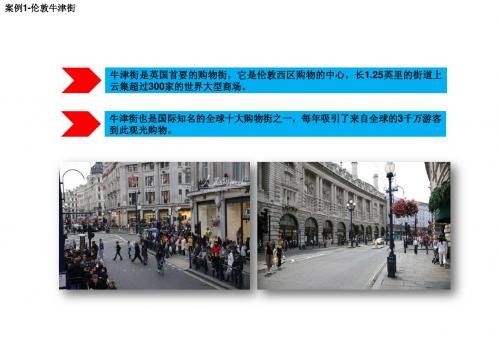
案例2-香港1881 Heritage
由120年历史的前水警总部旧址为基础,融合新旧设计 打造成维多利亚式的建筑风格
案例2-香港1881 Heritage
云集多家国际级品牌珠宝、 世界名表、著名时装设计品 牌机高级精品等,大部分店 均以旗舰店形式经营,品牌 密集度高。
案例3-米兰黄金四角区
由四条名品店街组成的著名米兰购物 黄金四角区,全球时尚人士的朝圣地
案例1-伦敦牛津街
牛津街云集了众多知名百货商场Selfridges, Debenhams等,顶级品牌更是遍布全街。
Selfridges
案例1-伦敦牛津街
牛津街建筑特色古典,并结合现代时尚前卫等元素,体现出优雅高傲的独特风格。 历史底蕴深厚,从罗马时代到17世纪,牛津街就已经以主干道路的形式存在。
香港1881 Heritage
米兰黄金四角区
国际知名度
区域性知名度高
具有全球知名度
历史底蕴
17世纪建筑
殖民地时期
文艺复兴时期建筑
形象定位
著名百货公司与高端品 牌交错的旅游购物街 四个地体站口贯穿全街 交通方便
高端品牌众多 密集度高
世界顶级奢侈品牌 时尚之都 由四条时尚品牌街区组 成黄金四角
特色
与文娱产业错位发展
案例3-米兰黄金四角区
文艺复兴时期建筑 古老 典雅 装饰丰富多彩 与时尚完美结合
案例3-米兰黄金四角区
几乎包罗所有世界大牌,其 中有很多旗舰店 米兰时尚流行都会的所在地 世界各国著名的设计师及高 端时尚品牌的专卖店 最新的、未来的时尚趋势都 可以在这里发现
案例-小结
伦敦牛津街
全球十大购物街之一 知名度极高
案例1-伦敦牛津街
全球最奢华的购物中心
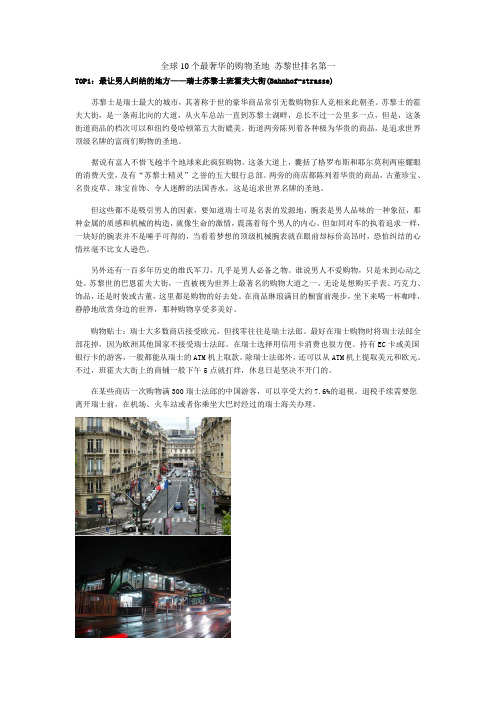
全球10个最奢华的购物圣地苏黎世排名第一TOP1:最让男人纠结的地方——瑞士苏黎士班霍夫大街(Bahnhof-strasse)苏黎士是瑞士最大的城市,其著称于世的豪华商品常引无数购物狂人竞相来此朝圣。
苏黎士的霍夫大街,是一条南北向的大道,从火车总站一直到苏黎士湖畔,总长不过一公里多一点,但是,这条街道商品的档次可以和纽约曼哈顿第五大街媲美。
街道两旁陈列着各种极为华贵的商品,是追求世界顶级名牌的富商们购物的圣地。
据说有富人不惜飞越半个地球来此疯狂购物。
这条大道上,囊括了格罗布斯和耶尔莫利两座耀眼的消费天堂,及有“苏黎士精灵”之誉的五大银行总部。
两旁的商店都陈列着华贵的商品,古董珍宝、名贵皮草、珠宝首饰、令人迷醉的法国香水,这是追求世界名牌的圣地。
但这些都不是吸引男人的因素,要知道瑞士可是名表的发源地,腕表是男人品味的一种象征,那种金属的质感和机械的构造,就像生命的激情,震荡着每个男人的内心。
但如同对车的执着追求一样,一块好的腕表并不是唾手可得的,当看着梦想的顶级机械腕表就在眼前却标价高昂时,恐怕纠结的心情丝毫不比女人逊色。
另外还有一百多年历史的维氏军刀,几乎是男人必备之物。
谁说男人不爱购物,只是未到心动之处。
苏黎世的巴恩霍夫大街,一直被视为世界上最著名的购物大道之一。
无论是想购买手表、巧克力、饰品,还是时装或古董,这里都是购物的好去处。
在商品琳琅满目的橱窗前漫步,坐下来喝一杯咖啡,静静地欣赏身边的世界,那种购物享受多美好。
购物贴士:瑞士大多数商店接受欧元,但找零往往是瑞士法郎。
最好在瑞士购物时将瑞士法郎全部花掉,因为欧洲其他国家不接受瑞士法郎。
在瑞士选择用信用卡消费也很方便。
持有EC卡或美国银行卡的游客,一般都能从瑞士的ATM机上取款。
除瑞士法郎外,还可以从ATM机上提取美元和欧元。
不过,班霍夫大街上的商铺一般下午5点就打烊,休息日是坚决不开门的。
在某些商店一次购物满300瑞士法郎的中国游客,可以享受大约7.6%的退税。
全球十大人气爆棚商业街排行榜
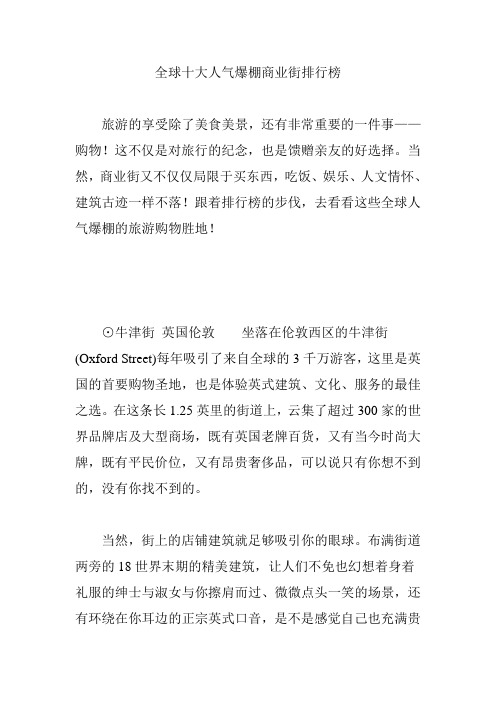
全球十大人气爆棚商业街排行榜旅游的享受除了美食美景,还有非常重要的一件事——购物!这不仅是对旅行的纪念,也是馈赠亲友的好选择。
当然,商业街又不仅仅局限于买东西,吃饭、娱乐、人文情怀、建筑古迹一样不落!跟着排行榜的步伐,去看看这些全球人气爆棚的旅游购物胜地!⊙牛津街英国伦敦坐落在伦敦西区的牛津街(Oxford Street)每年吸引了来自全球的3千万游客,这里是英国的首要购物圣地,也是体验英式建筑、文化、服务的最佳之选。
在这条长1.25英里的街道上,云集了超过300家的世界品牌店及大型商场,既有英国老牌百货,又有当今时尚大牌,既有平民价位,又有昂贵奢侈品,可以说只有你想不到的,没有你找不到的。
当然,街上的店铺建筑就足够吸引你的眼球。
布满街道两旁的18世界末期的精美建筑,让人们不免也幻想着身着礼服的绅士与淑女与你擦肩而过、微微点头一笑的场景,还有环绕在你耳边的正宗英式口音,是不是感觉自己也充满贵族气息了呢?⊙第五大道美国纽约成都去眼袋有不手术的技术吗?去眼袋到成都健丽不开刀去眼袋! [健丽]明星去眼袋御用机构预约特价1800 纽约曼哈顿闻名全球的第五大道(Fifth Avenue)称得上是全球最贵的购物街,不仅因为这里汇聚着世界顶级品牌,店铺的年租金更是高的惊人。
有些人来第五大道为了购物,也有些人则只为一睹它的样貌。
抬头仰望,玻璃幕墙闪闪发亮的高楼大厦,各式各样的广告牌,狭窄的天空。
你可以沿着大道步行感受它的繁华,也可以坐车匆匆的欣赏。
从洛克菲勒中心到第58街的路段上,爱马仕(近62街)、香奈儿(近64街)、LV(近57街)、蒂凡尼(近57街)、宝格丽(近57街),卡迪亚(近58街)、欧米伽(近55街),一连串的奢侈品店让人眼花缭乱,不由得想起电影《蒂凡尼早餐》中奥黛丽·赫本每天早上都会来到Tiffany橱窗前,一边吃着手中的面包,一边幻想着有一天自己能够在高贵的珠宝店里享受轻松的早餐的场景。
设置单行道案例
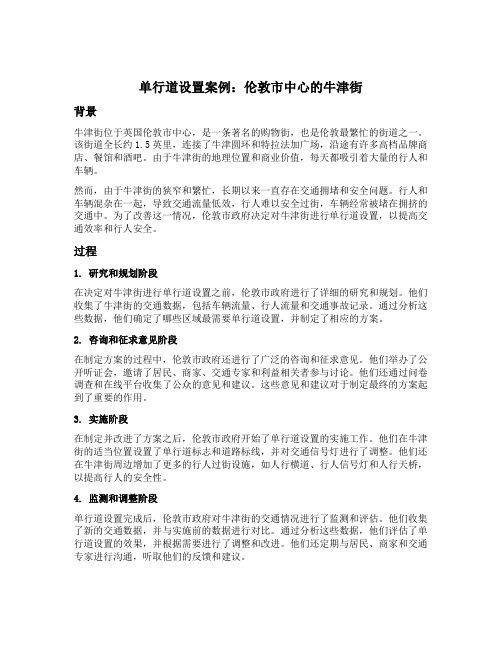
单行道设置案例:伦敦市中心的牛津街背景牛津街位于英国伦敦市中心,是一条著名的购物街,也是伦敦最繁忙的街道之一。
该街道全长约1.5英里,连接了牛津圆环和特拉法加广场,沿途有许多高档品牌商店、餐馆和酒吧。
由于牛津街的地理位置和商业价值,每天都吸引着大量的行人和车辆。
然而,由于牛津街的狭窄和繁忙,长期以来一直存在交通拥堵和安全问题。
行人和车辆混杂在一起,导致交通流量低效,行人难以安全过街,车辆经常被堵在拥挤的交通中。
为了改善这一情况,伦敦市政府决定对牛津街进行单行道设置,以提高交通效率和行人安全。
过程1. 研究和规划阶段在决定对牛津街进行单行道设置之前,伦敦市政府进行了详细的研究和规划。
他们收集了牛津街的交通数据,包括车辆流量、行人流量和交通事故记录。
通过分析这些数据,他们确定了哪些区域最需要单行道设置,并制定了相应的方案。
2. 咨询和征求意见阶段在制定方案的过程中,伦敦市政府还进行了广泛的咨询和征求意见。
他们举办了公开听证会,邀请了居民、商家、交通专家和利益相关者参与讨论。
他们还通过问卷调查和在线平台收集了公众的意见和建议。
这些意见和建议对于制定最终的方案起到了重要的作用。
3. 实施阶段在制定并改进了方案之后,伦敦市政府开始了单行道设置的实施工作。
他们在牛津街的适当位置设置了单行道标志和道路标线,并对交通信号灯进行了调整。
他们还在牛津街周边增加了更多的行人过街设施,如人行横道、行人信号灯和人行天桥,以提高行人的安全性。
4. 监测和调整阶段单行道设置完成后,伦敦市政府对牛津街的交通情况进行了监测和评估。
他们收集了新的交通数据,并与实施前的数据进行对比。
通过分析这些数据,他们评估了单行道设置的效果,并根据需要进行了调整和改进。
他们还定期与居民、商家和交通专家进行沟通,听取他们的反馈和建议。
结果单行道设置对牛津街的交通状况和行人安全产生了积极的影响。
以下是一些主要结果:1. 交通流量提高单行道设置使牛津街的交通流量得到了明显的改善。
参观英国的大街英文作文
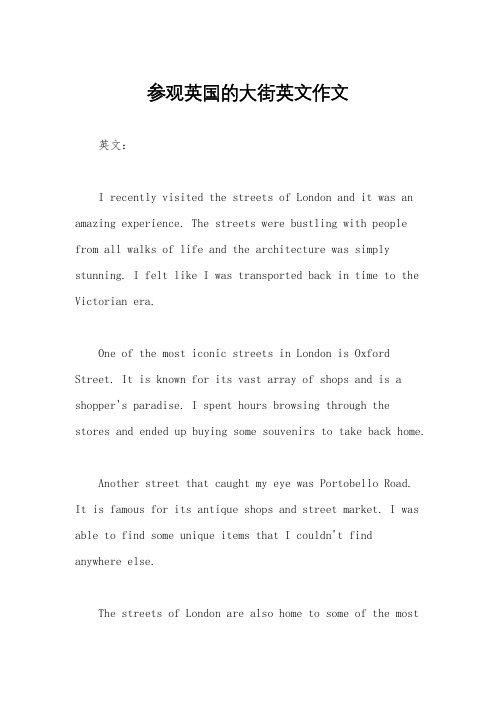
参观英国的大街英文作文英文:I recently visited the streets of London and it was an amazing experience. The streets were bustling with people from all walks of life and the architecture was simply stunning. I felt like I was transported back in time to the Victorian era.One of the most iconic streets in London is Oxford Street. It is known for its vast array of shops and is a shopper's paradise. I spent hours browsing through thestores and ended up buying some souvenirs to take back home.Another street that caught my eye was Portobello Road.It is famous for its antique shops and street market. I was able to find some unique items that I couldn't find anywhere else.The streets of London are also home to some of the mosthistoric landmarks in the world. I visited the Tower of London and was amazed by the history behind it. I also visited Buckingham Palace and saw the changing of the guard, which was a truly remarkable experience.Overall, my visit to the streets of London was an unforgettable experience. The sights, sounds, and smells were all so different from what I'm used to and I loved every minute of it.中文:我最近参观了伦敦的大街小巷,这是一次令人惊叹的经历。
- 1、下载文档前请自行甄别文档内容的完整性,平台不提供额外的编辑、内容补充、找答案等附加服务。
- 2、"仅部分预览"的文档,不可在线预览部分如存在完整性等问题,可反馈申请退款(可完整预览的文档不适用该条件!)。
- 3、如文档侵犯您的权益,请联系客服反馈,我们会尽快为您处理(人工客服工作时间:9:00-18:30)。
英国伦敦牛津街OXford street牛津街是英国首要的购物街,每年吸引了来自全球的3千万游客到此观光购物。
它是伦敦西区购物的中心,是英国最繁忙的街道。
众多的购物者都被这条长1.25英里的街道上云集的超过300家的世界大型商场所吸引。
牛津街享有遍及全球的声誉,它不仅吸引了英国其它地方的游客,也吸引了大量的海外游客。
据估计,每年有9百万外国游客来这里参观购物,他们在这里的消费占牛津街全部收入的20%。
如同零售一样,这条街也是千万人的工作场所。
在圣诞节的高峰时期,这里有大约6万人。
牛津街还为伦敦的中心提供了一条重要的交通干线,每小时有50辆公共汽车运行,4个地铁站与5条线路相连,从而确保了公共运输网的核心地理位置。
历史从罗马时代直到17世纪,牛津街主要室作为从伦敦西城之外到牛津地区的线路而存在的。
那时最东部地区已经在南边有所发展,但是北边还没有什么重大发展。
18世纪末期,主要的有大片建筑物的土地的兴建,即南部高斯弯那Grosvenor,北部波特曼Portman和波特兰Portland (今日的霍华德沃顿Howard de Walden) 的兴建使得牛津街很大程度上成为现在的样子。
一流的购物中心在20世纪开始起步,同时也伴随着一些正在向主要商店发展的小店铺的开业,像1865年首次开业的赛尔夫瑞至(Selfridges),它比较大的一部分在1929年才面向公众。
现在的情形2001年1月对牛津街零售商进行的调查表明,对于2/3的受调查人来说,买卖金额普遍有所升高,且预期在今后12个月里还会升高。
然而55%的人们坚持认为牛津街的综合贸易额受到了蓝水(Blue Water)——一家最近在伦敦东边城外建造的购物中心——的不利影响。
这也是为什么有越来越多的声音呼吁牛津街在环境上更进一步优化治理的原因之一。
以前的改进牛津街,牛津广场西部的改进是在1992年2月到1995年11月期间实行的。
方案是通过资金计划,根据商业贡献制订的。
所设计的改进方案是希望通过更好的交通管理来达到改造行人空间,改造环境和设施,增强安全的目的。
这些改进包括很多方面:拓宽并用浅黄的约克色调(York Tone)重铺人行道;重新组织摆放街边摆设,使砌边石后面的街道干净整洁,以便给行人留出无障碍物的通道;把电话亭挪进小巷安置;有选择地封闭一些小巷,从而提供一条更连贯的人行道,既保障了行人的安全,也避免了一些受限制的车辆进入大街;建立新的双重目的的照明系统,从一根电线杆上瑶同时照射车道和人行道,这些电线杆上还要有能安置旗帜横幅的连接物;修建公共汽车的路边停车处,等等。
这些改进原本计划从牛津广场一直向东延伸,由于金融的约束力,改进被拖延;同时由于建筑物安全条例,关闭牛津街是要求出台,这对于依然保持单向交通的处于初始阶段的工程来说并不是必须的。
进一步的改进目前有一份关于牛津街东区进一步改善环境治理的提议,预期在2001年8月开始贯彻实施。
这些改进措施将包括增加18%的人行道空间,改善街道照明系统,使街道布局更为合理,7.5米的车道和改良后的行人过街设施。
这些工作计划将在2002年3月以前完成,预计耗资3.25百万英磅。
这些工作将在与牛津街协会的磋商下实行,这一协会为其提供财政支持。
协会成员是由大街的主要地产主组成的。
由牛津街的前期居住者组成的新西区公司也会进行财政帮助。
Oxford streetOxford Street is the UK’S premier shopping street attracting some 30 million visitors from around the world every year. It represents the heart of London’s West End shopping making it Britain’s busiest street with shoppers attracted by one of the highest concentrations of large shops in the world with more than 300 in total along its one and a quarter mile length.It has a world-wide reputation and attracts many visitors from both the rest of Britain and overseas. An estimated nine million foreign tourists visit the street each year and account for about 20% of its income. As well as retail the street is theworkplace for thousands of people, about sixty thousand during the peak Christmas period. The Street also provides a vital transport artery in the heart of London carrying 250 buses an hour and four Underground stations supporting five lines which ensures its geographic position at the center of the capitals public transport network..HistoryFrom Roman times until the end of the seventeenth century Oxford Street existed primarily as a route out of the city of London westward to Oxford. The extreme eastern end had development on the south side but there was no significant development on the northern side. By the end of the eighteenth century however the growth of major estates, Grosvenor to the south and Portman and Portland (now Howard de Walden) to the north had largely fixed the line of Oxford Street that exists today. The prime shopping center really began to develop in the twentieth century with the opening of the major stores, often developing from smaller shops, for example Selfridges which first opened in 1865 but the larger part of the store didn’t open until 1909.Current SituationA recent Oxford Street Retailers Survey, undertaken in January 2001 has shown that the trading performance has been generally up with two thirds of the respondents expecting it to increase over the next twelve months. However 55% maintain that Oxford Street general trade has been adversely affected by Blue. Water-the recent out of town shopping center built to the ease of London. This is one of the reasons for the increasing calls for further environmental enhancements to Oxford Street.Previous ImprovementsImprovements to Oxford Street, west of Oxford Circus, were carried out between February 1992 and November 1995. The scheme was funded through the Capital Programme, with contributions from businesses. The improvements were designed to improve pedestrian space, the environment and facilities and to improve safety through the better control of traffic. These improvements included, widening and re-paving the footways with York Tone buff coloured paving. Replacing and reorganising the street furniture into one neat line behind the kerb to leave an unobstructed walkway for pedestrians. Relocating telephone booths to the sidestreets. Closing off selected sidestreets to provide a more continuous footway enhancingpedestrian safety and preventing restricted traffic from entering the street. Erecting new, dual purpose lighting covering both the carriageway and footway from one post. The posts also included attachments enabling banners to be put up. Creating bus lay-bys….These improvements were originally intended to be carried further east along OxfordStreet(Oxford Street east) from Oxford Circus. The improvements were stalled due to financial constraints and the requirement to close the street due to changes in construction safety regulations, which was not necessary for the previous phases of the work where one way traffic was maintained.Further ImprovementsCurrently there is a proposal for further environmental improvements for the eastern section of Oxford Street with implementation expected to start in August 2001. These improvements would include upgrading and increasing the footway space by 18%, improving street lighting, rationalizing street furniture, a 7.5m carriageway and improved pedestrian crossing facilities. This work is scheduled for completion by March 2002 and estimated to cost 3.52m.This work will be carried out in consultation with the Oxford Street Association who is contributing financially to it. The association is made up of the major landowners on the street. There is also the New West End Company, which is made up of the occupiers of the premises on Oxford Street.感谢您的阅读!。
